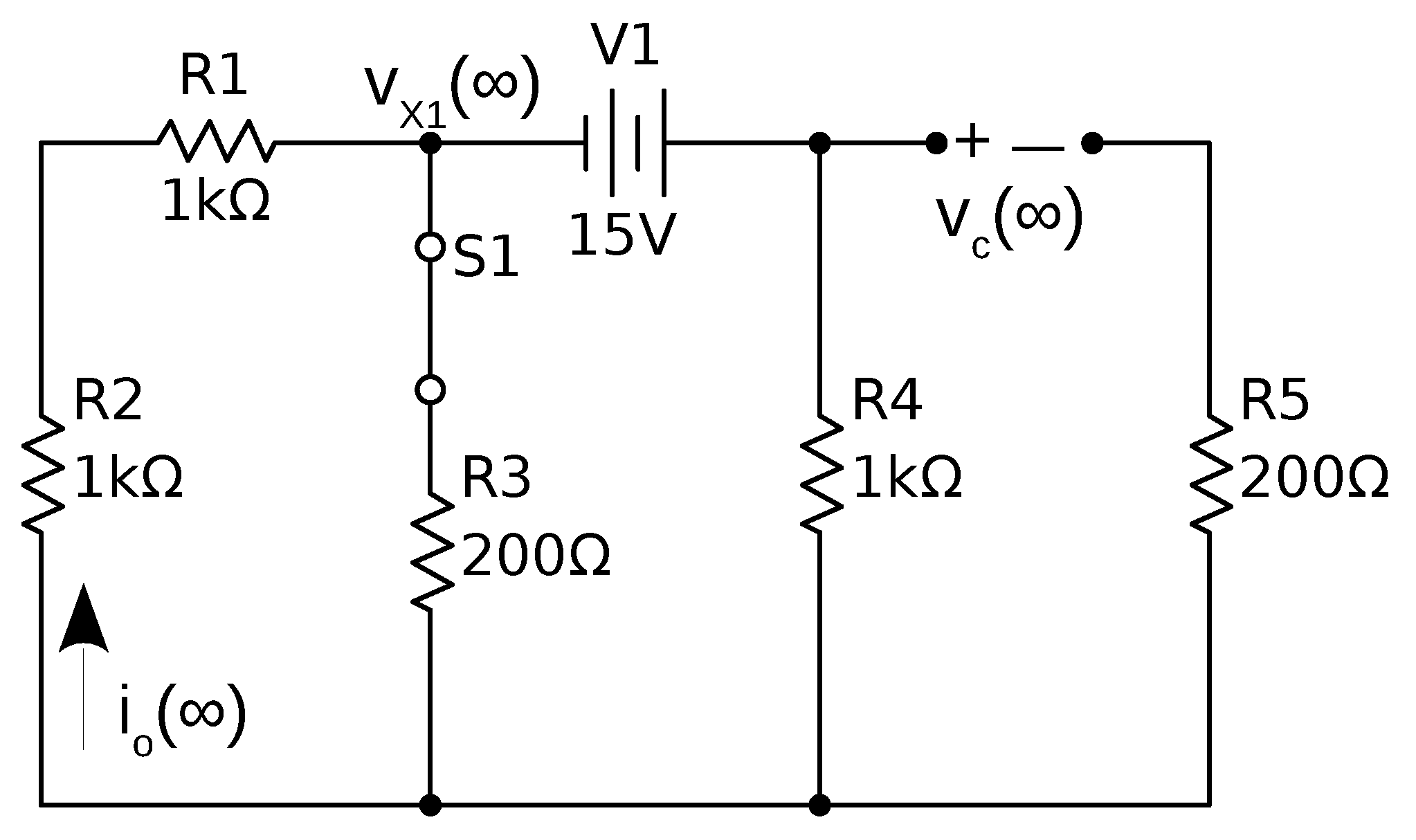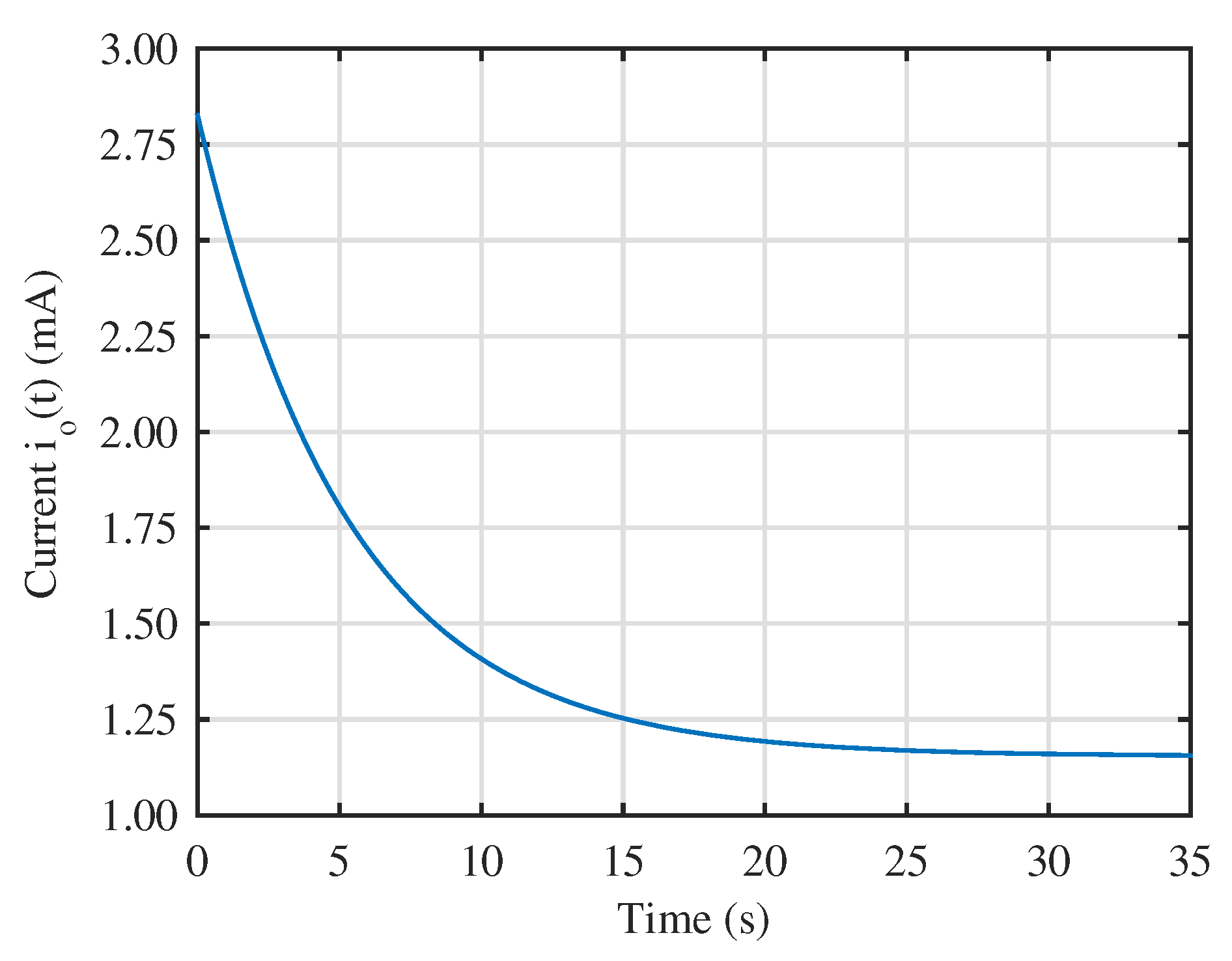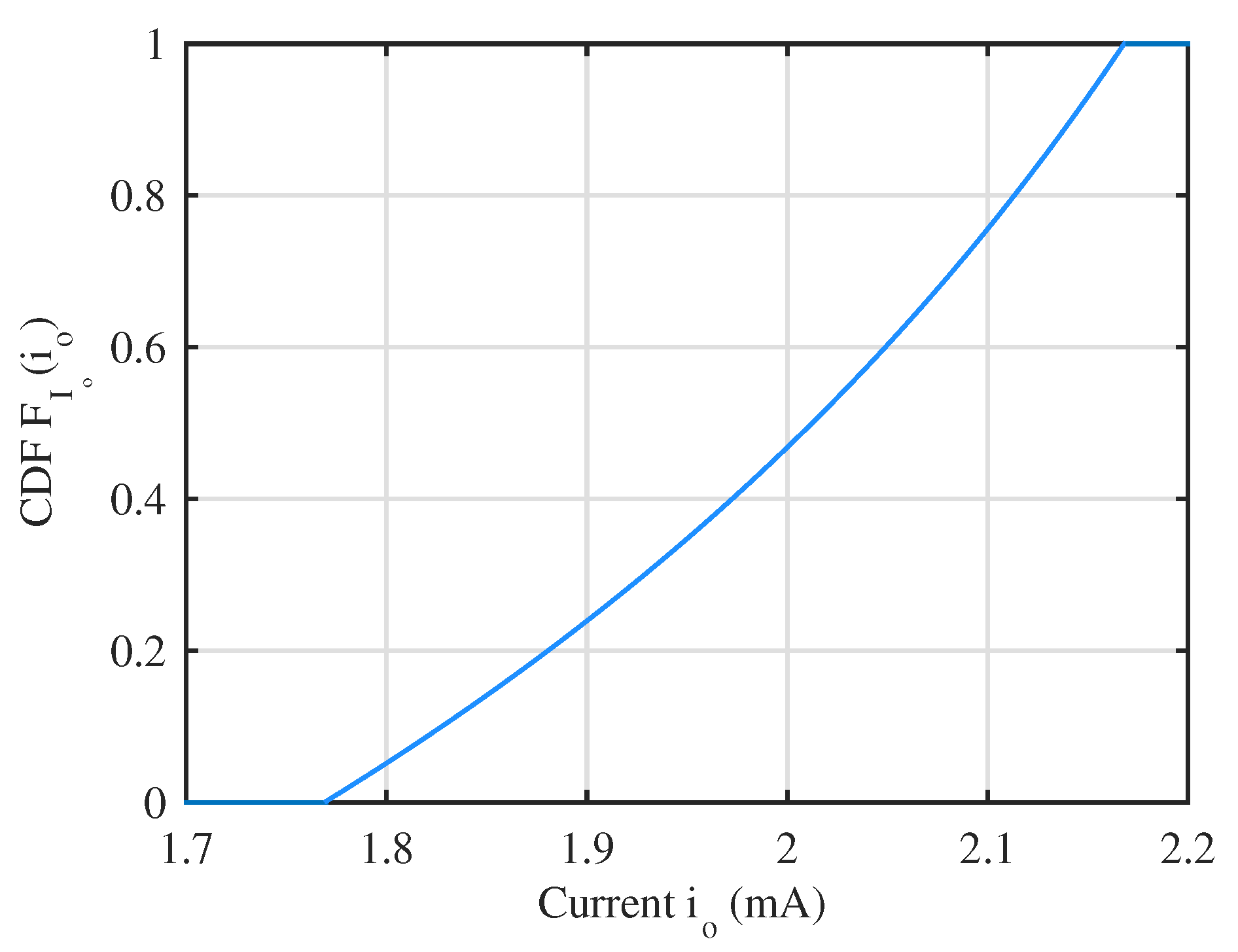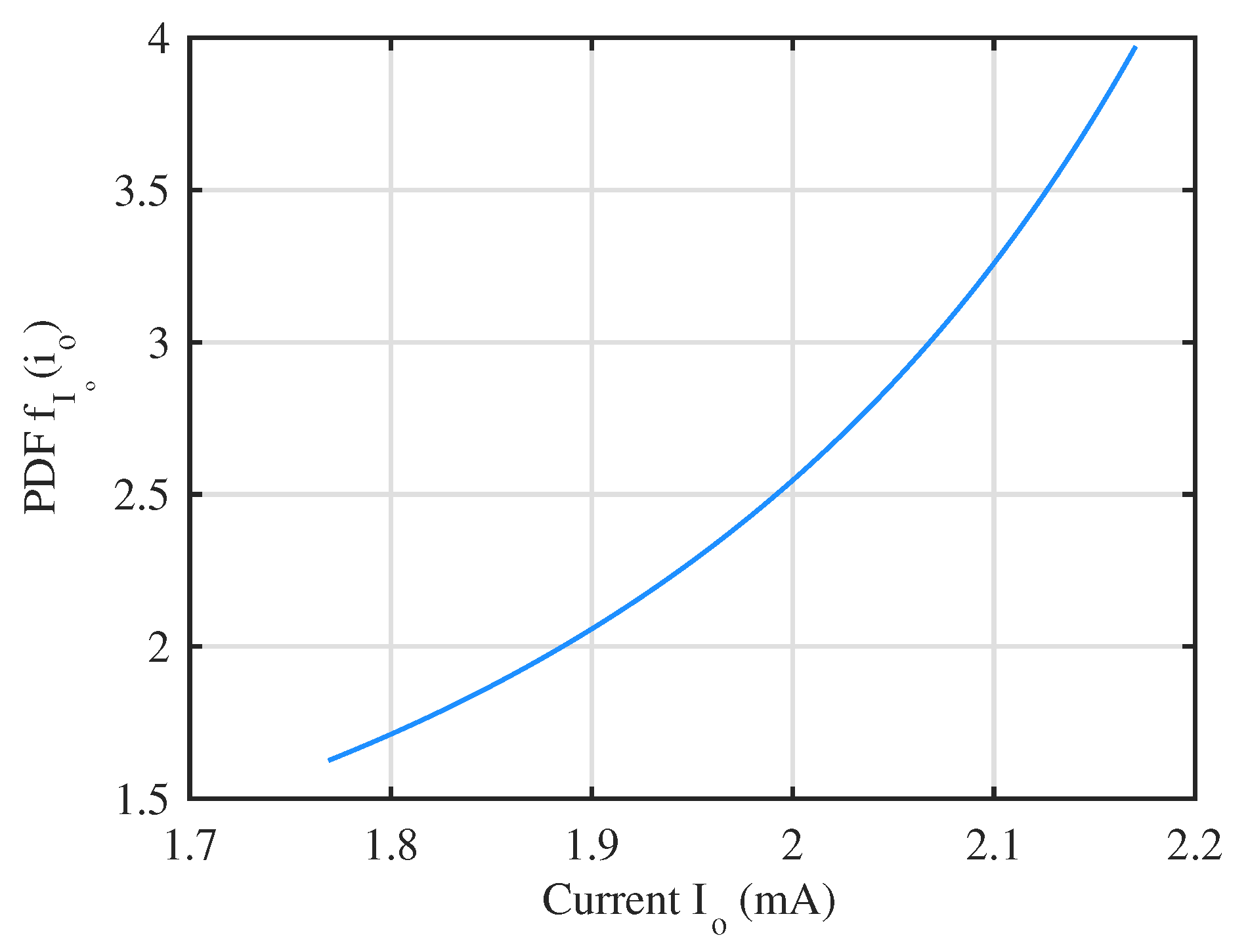An Investigation of the Transient Response of an RC Circuit with an Unknown Capacitance Value Using Probability Theory
Abstract
:1. Introduction
2. Determination of Circuit Response
3. Probability Model
3.1. Probability Distribution of
3.2. Validity Check
3.3. Utilization of the Probability Model
4. Probability Models of Other Parameters
- Voltage at node ;
- Current through the resistor R3;
- Voltage at node .
4.1. Voltage
Example for the Probability Model of
4.2. Current through Resistor R3
Example for the Probability Model of
4.3. Voltage
Example for the Probability Model of
5. Conclusions
Author Contributions
Funding
Institutional Review Board Statement
Informed Consent Statement
Data Availability Statement
Conflicts of Interest
References
- Zheng, S.; Kang, Z.; Li, L.; Zhang, A.; Zhao, K.; Zhou, Y. Influence of series RC circuit parameters on the streamer discharge process of gas spark switch. Vacuum 2021, 193, 110518. [Google Scholar] [CrossRef]
- Qureshi, S.; Chang, M.M.; Shaikh, A.A. Analysis of series RL and RC circuits with time-invariant source using truncated M, Atangana beta and conformable derivatives. J. Ocean. Eng. Sci. 2021, 6, 217–227. [Google Scholar] [CrossRef]
- Wang, K.J.; Sun, H.C.; Fei, Z. The transient analysis for zero-input response of fractal RC circuit based on local fractional derivative. Alex. Eng. J. 2020, 59, 4669–4675. [Google Scholar] [CrossRef]
- Zhu, Q.; Zhou, M.; Qiao, Y.; Wu, N.; Hou, Y. Multiobjective Scheduling of Dual-Blade Robotic Cells in Wafer Fabrication. IEEE Trans. Syst. Man Cybern. Syst. 2020, 50, 5015–5023. [Google Scholar] [CrossRef]
- Koo, J.; Kim, B.; Park, H.J.; Sim, J.Y. A Quadrature RC Oscillator With Noise Reduction by Voltage Swing Control. IEEE Trans. Circuits Syst. Regul. Pap. 2019, 66, 3077–3088. [Google Scholar] [CrossRef]
- Sevilmiş, F.; Karaca, H. An advanced hybrid pre-filtering/in-loop-filtering based PLL under adverse grid conditions. Eng. Sci. Technol. Int. J. 2021, 24, 1144–1152. [Google Scholar] [CrossRef]
- Li, C.; Chen, S.; Luo, H.; Li, C.; Li, W.; He, X. A Modified RC Snubber with Coupled Inductor for Active Voltage Balancing of Series-Connected SiC MOSFETs. IEEE Trans. Power Electron. 2021, 36, 11208–11220. [Google Scholar] [CrossRef]
- Ebrahim, M.A.; Elyan, T.; Wadie, F.; Abd-Allah, M.A. Optimal design of RC snubber circuit for mitigating transient overvoltage on VCB via hybrid FFT/Wavelet Genetic approach. Electr. Power Syst. Res. 2017, 143, 451–461. [Google Scholar] [CrossRef]
- Momeni, M.; Moezzi, M. A Low Loss and Area Efficient RC Passive Poly Phase Filter for Monolithic GHz Vector-Sum Circuits. IEEE Trans. Circuits Syst. II Express Briefs 2019, 66, 1134–1138. [Google Scholar] [CrossRef]
- Merlo, L.; Di Biccari, L.; Cerati, L.; Andreini, A. Design of RC trigger circuit for dynamically activated ESD protections ensuring application requirements and ESD performances. Microelectron. Reliab. 2022, 138, 114685. [Google Scholar] [CrossRef]
- Ding, C.; Nie, T.; Tian, X.; Chen, T.; Yuan, Z. Analysis of the influence of RC buffer on DC solid-state circuit breaker. Energy Rep. 2020, 6, 1483–1489. [Google Scholar] [CrossRef]
- Chen, J.; Luo, Q.; Huang, J.; He, Q.; Sun, P.; Du, X. Analysis and Design of an RC Snubber Circuit to Suppress False Triggering Oscillation for GaN Devices in Half-Bridge Circuits. IEEE Trans. Power Electron. 2020, 35, 2690–2704. [Google Scholar] [CrossRef]
- Dou, G.; Zhang, Y.; Yang, H.; Han, M.; Guo, M.; Gai, W. RC Bridge Oscillation Memristor Chaotic Circuit for Electrical and Electronic Technology Extended Simulation Experiment. Micromachines 2023, 14, 410. [Google Scholar] [CrossRef] [PubMed]
- Wan, F.; Gu, T.; Ravelo, B.; Li, B.; Cheng, J.; Yuan, Q.; Ge, J. Negative Group Delay Theory of a Four-Port RC-Network Feedback Operational Amplifier. IEEE Access 2019, 7, 75708–75720. [Google Scholar] [CrossRef]
- Lavalle-Aviles, F.; Sánchez-Sinencio, E. A 0.6-V Power-Efficient Active-RC Analog Low-Pass Filter with Cutoff Frequency Selection. IEEE Trans. Very Large Scale Integr. Syst. 2020, 28, 1757–1769. [Google Scholar] [CrossRef]
- Cheong, H.G.; Kim, Y.S.; Chu, C.N. Machining Characteristics of an RC-type Generator Circuit With an N-channel MOSFET in Micro EDM. Procedia CIRP 2018, 68, 631–636. [Google Scholar] [CrossRef]
- Wu, S.L.; Al-Khaleel, M. Convergence analysis of the Neumann–Neumann waveform relaxation method for time-fractional RC circuits. Simul. Model. Pract. Theory 2016, 64, 43–56. [Google Scholar] [CrossRef]
- Farooq-i-Azam, M.; Farooq, M.O. Probability model of the exponentially rising transient response of a failed RC circuit. Eng. Fail. Anal. 2022, 142, 106770. [Google Scholar] [CrossRef]
- Farooq-i-Azam, M.; Khan, Z.H.; Hassan, S.R.; Asif, R. Probabilistic Analysis of an RL Circuit Transient Response under Inductor Failure Conditions. Electronics 2022, 11, 4051. [Google Scholar] [CrossRef]
- Yu, W.; de la Rosa, E. Neural Modeling with Guaranteed Input-Output Probability Distributions. IEEE Trans. Syst. Man Cybern. Syst. 2020, 51, 6660–6668. [Google Scholar] [CrossRef]
- Seliem, H.; Shahidi, R.; Ahmed, M.H.; Shehata, M.S. Accurate Probability Distribution Calculation for Drone-Based Highway-VANETs. IEEE Trans. Veh. Technol. 2020, 69, 1127–1130. [Google Scholar] [CrossRef]
- Bahri, Z. Asymptotic series expansion for the probability density function of the interference due to Faster-Than-Nyquist signaling. Eng. Sci. Technol. Int. J. 2017, 20, 1507–1514. [Google Scholar] [CrossRef]
- Singh, K.K.; Yadav, P.; Singh, A.; Dhiman, G.; Cengiz, K. Cooperative spectrum sensing optimization for cognitive radio in 6 G networks. Comput. Electr. Eng. 2021, 95, 107378. [Google Scholar] [CrossRef]
- Quan, Q.; Cui, G.; Du, G.X. Controllable probability and optimization of multicopters. Aerosp. Sci. Technol. 2021, 119, 107162. [Google Scholar] [CrossRef]
- Abdul Majid, A. Forecasting Monthly Wind Energy Using an Alternative Machine Training Method with Curve Fitting and Temporal Error Extraction Algorithm. Energies 2022, 15, 8596. [Google Scholar] [CrossRef]
- Ghahramani, Z. Probabilistic machine learning and artificial intelligence. Nature 2015, 521, 452–459. [Google Scholar] [CrossRef] [PubMed]
- Anthony, M. Probability Theory in Machine Learning. In Encyclopedia of the Sciences of Learning; Seel, N.M., Ed.; Springer: Boston, MA, USA, 2012; pp. 2677–2680. [Google Scholar] [CrossRef]
- Ranftl, S. A Connection between Probability, Physics and Neural Networks. Phys. Sci. Forum 2022, 5, 11. [Google Scholar] [CrossRef]
- Murphy, K.P. Probabilistic Machine Learning: An Introduction; MIT Press: Cambridge, MA, USA, 2022. [Google Scholar]
- Murphy, K.P. Probabilistic Machine Learning: Advanced Topics; MIT Press: Cambridge, MA, USA, 2023. [Google Scholar]








Disclaimer/Publisher’s Note: The statements, opinions and data contained in all publications are solely those of the individual author(s) and contributor(s) and not of MDPI and/or the editor(s). MDPI and/or the editor(s) disclaim responsibility for any injury to people or property resulting from any ideas, methods, instructions or products referred to in the content. |
© 2023 by the authors. Licensee MDPI, Basel, Switzerland. This article is an open access article distributed under the terms and conditions of the Creative Commons Attribution (CC BY) license (https://creativecommons.org/licenses/by/4.0/).
Share and Cite
Farooq-i-Azam, M.; Khan, Z.H.; Ghani, A.; Siddiq, A. An Investigation of the Transient Response of an RC Circuit with an Unknown Capacitance Value Using Probability Theory. Symmetry 2023, 15, 1378. https://doi.org/10.3390/sym15071378
Farooq-i-Azam M, Khan ZH, Ghani A, Siddiq A. An Investigation of the Transient Response of an RC Circuit with an Unknown Capacitance Value Using Probability Theory. Symmetry. 2023; 15(7):1378. https://doi.org/10.3390/sym15071378
Chicago/Turabian StyleFarooq-i-Azam, Muhammad, Zeashan Hameed Khan, Arfan Ghani, and Asif Siddiq. 2023. "An Investigation of the Transient Response of an RC Circuit with an Unknown Capacitance Value Using Probability Theory" Symmetry 15, no. 7: 1378. https://doi.org/10.3390/sym15071378
APA StyleFarooq-i-Azam, M., Khan, Z. H., Ghani, A., & Siddiq, A. (2023). An Investigation of the Transient Response of an RC Circuit with an Unknown Capacitance Value Using Probability Theory. Symmetry, 15(7), 1378. https://doi.org/10.3390/sym15071378


_Yi.png)





